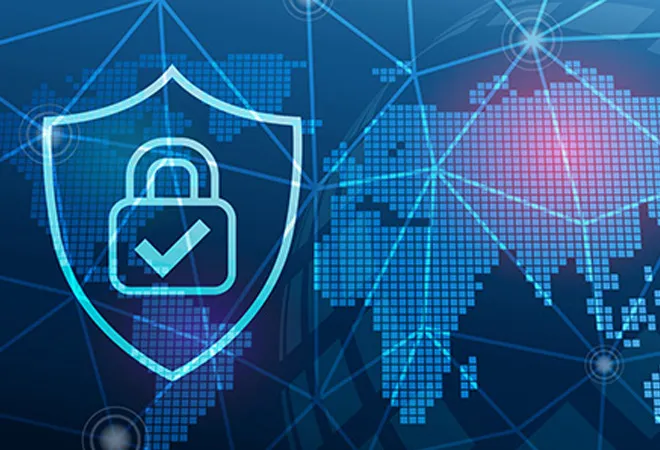
The global and interconnected internet is slowly but steadily giving way to a new balkanised reality. This new splinternet is a
collection of fragmented networks controlled by governments and corporations. Geopolitical tensions and the rise of digital authoritarianism have often situated the debate on the splinternet’s nature within a larger conversation,
juxtaposing democracies with autocracies. Others have emphasised
three visions, i.e., a liberal American, a regulated European, and an illiberal approach to the internet as undertaken by authoritarian countries such as China and Russia.
A focus on solely the regime and governance type previously positioned India as a global swing state or digital decider in a bipolar world order, and indeed, India’s position towards a global internet is not congruent with one that has been already conceptualised . Yet, this essay discards previous notions by focusing on India’s concrete political and economic objectives and developments in the recent past. Balancing nationalist and international aspirations, India’s perspectives towards the internet are reflective of seemingly opposing political interests currently present in various legislations around the world.
By emphasising India’s domestic capacity-building priorities and the emerging norms regarding a global internet, we argue that India is navigating towards a model of “Digital Osmosis”. India attempts to absorb the main tenets of both the capitalist-liberal internet as well as the centralised-restricted internet vision and continues to build foundations for a largely government-monitored internet which blends well with a majority of the open internet’s glocalised goods and services proliferation.
Balancing nationalist and international aspirations, India’s perspectives towards the internet are reflective of seemingly opposing political interests currently present in various legislations around the world.
We theorise digital osmosis as a political compromise where decision-makers seek to balance profits from international engagements with national security considerations. India is a champion of digital osmosis as it engages both, the global internet and its own splintered network within it.
Legal inroads and mixed messaging from Delhi
India’s regulatory developments with respect to Information and Communications Technology (ICTs) have generally been limited over the past couple of decades. The
Information Technology Act 2000 and its offshoots, through several new amendments in the Information Technology Rules (ITR’s), have acted as the main protecteurs of government interests. While civil societies constantly calls out the rules’ shortcomings for personal data protection, domestic and international companies continue to face challenges without clear legal positions on data storage, transfer, and protection. After several drafts and revisions of the now-called
Digital Personal Data Protection Bill since 2019, India has recently departed from a strict data localisation approach which would have significantly regulated the flow of personal and non-personal data out of India. While the most resolute proscriptions on data localisation have been discarded in the recent draft, it allows the government to block the transfer of data originating from India “in the interests of sovereignty and integrity of India” and “security of the State.” Parallely, India has started to leverage its IT industry and large business conglomerates to build data centres around India which can host the still-growing amounts of personal data in the country.
In its regulatory efforts, India showcases none of the structurally isolationist features like a digital firewall or an extensive use of content blocks. Instead, its preference for law and order politics has been the key constraining element for India’s global digital connectivity. Most significantly, the COVID-19 pandemic coupled with geopolitical tensions with China since early 2020 resulted in spikes of nationalistic tendencies in the Indian policy landscape, and led to the technological decoupling of India with China as a result. India
banned over 250 Chinese apps, including big global players like TikTok, WeChat and UC Browser, citing national security concerns regarding the gathering and improper usage of sensitive user data in a hostile nation. Frequent instances of localised internet shutdowns confirm the executive preference for security over connectivity. While the Chinese app ban suggests that less Indian internet traffic will be routed through Chinese servers, India’s domestic policing is shaping internet exchange in and out of India.
Indian companies continue to build international digital highways
India has realised that to be a leader in ICT, it must be a pioneer. As with previous industrial revolutions, the new and emerging technologies of cyberspace provide a tremendous advantage to first-mover nations. Since India’s economic liberalisation in the 1990s, the rising power has cultivated a new relationship between the public and the private sector. Their evolving relationship is driving the ground realities for India’s internet infrastructure.
India’s regulatory developments with respect to Information and Communications Technology (ICTs) have generally been limited over the past couple of decades.
The private sector in India has played a significant role in building global submarine cable networks. In the past decade, Reliance Jio Infocomm, TATA Communications, and Bharti Airtel have emerged as India’s most significant
submarine cable companies. Their recent and current projects have important geo-economic consequences. Jio’s India Asia Xpress (IAX) and India Europe Xpress (IEX) are planned to connect Mumbai with Singapore and Savona (Italy) in 2023 and 2024, respectively. Focusing their efforts on connecting India with the Gulf, the European Union, and Association of Southeast Asian Nations (ASEAN), Indian telecommunications companies reflect an economic interest in different markets.
International collaboration on ICT solutions remains a common business practice for Indian enterprises. Building the Indian cable network, Indian companies collaborate with Finnish Alcatel Submarine Networks (ASN) and Japan’s Fujitsu. Both companies are supplied by a variety of vendors from different countries. The construction and maintenance of submarine cables shows how India is part of the global internet infrastructure ecosystem. With a projected
US$ 1.6 trillion internet economy and
900 million internet users by 2025, India has increasing economic incentives to further integrate into digital global value chains (GVCs).
Silicon Valley vs Make in India
India’s software and public digital services sectors, however, also greatly benefit from cybersecurity solutions from key partners like Israel and the United States (US). The future integration of India’s internet with global networks will depend much on the upcoming legal evolution in India. The ongoing legal uncertainty so far has made both international investors as well as homegrown digital solutions wary. If this trend continues, international e-commerce and digital public goods may be driven away, only to be replaced by Indian entities which have not yet been optimised for the size and type of the Indian consumer demand.
The future integration of India’s internet with global networks will depend much on the upcoming legal evolution in India.
Indian digital solutions have had a moment since the kick-off of the
Aatmanirbhar Bharat App Innovation Challenge in 2020. The challenge produced several homegrown alternatives like Koo, Moj and Sharechat, each of which have several million daily users due to their provision of a host of vernacular Indian languages and curated content targeted towards Indian audiences. However, when it comes to social media platforms, American services with massive global user bases like WhatsApp, Facebook, Instagram, and Twitter continue to dominate the Indian market. Their superiority in various sectors is punctually regulated and constrained, and it was
noted by ORF in 2022 that while the urban Indian youth is generally supportive of the creation of indigenous applications in line with national interests, they still
prefer to use the more popular global platforms. In addition, with a diaspora of around 18 million Indians living around the world, India will continue to encounter certain pull factors towards keeping access to American social media and communications platforms open.
The degree to which India will remain connected to the global information landscape also depends on the success and failure of the US social media platforms in keeping its Indian userbases. So far, Indians continue to communicate through international platforms. If current trends manifest, India will remain a significant contributor to a global and interoperable internet while investing increasing resources in securing its cyber and information spaces with a focus on national security interests. The only real black box here is whether the Indian government will continue blocking global content critical of the government action and ideology in a targeted way or whether these content blocks will be extended to entire OTT platforms. Such a policy change would mean a complete departure from a partially liberal to a walled-garden approach.
The views expressed above belong to the author(s). ORF research and analyses now available on Telegram! Click here to access our curated content — blogs, longforms and interviews.



 The global and interconnected internet is slowly but steadily giving way to a new balkanised reality. This new splinternet is a
The global and interconnected internet is slowly but steadily giving way to a new balkanised reality. This new splinternet is a  PREV
PREV



